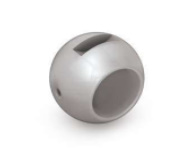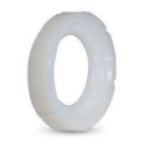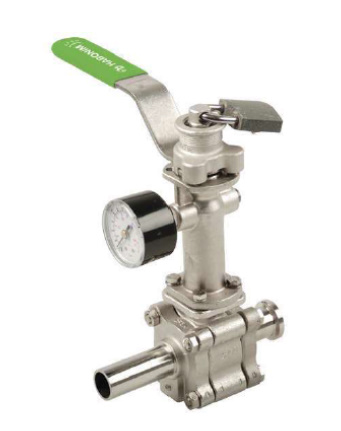Hydrogen
Hydrogen’s light atomic weight and molecule structure turning hydrogen-use equipment sealing into a challenge requires special designs, mechanisms and expertise. Hydrogen is highly combustion and flammable making leakage prevention an essence for safety and integrity of systems and materials selection should consider hydrogen effects as Hydrogen Embrittlement (HE).
Design:
Habonim Hydrogen-use ball valves incorporate some design elements to best accommodate the hydrogen media: Double Stem Sealing Habonim HermetiX patented stem seal is used with additional O-ring sealing. The HermetiX polymeric, non-graphite stem seal design is certified for ISO15848-1 and API641 fugitive emission prevention standards, tested with He. An additional O-ring stem seal is added as additional sealing point. This design has been successfully tested for 100,000 open/close cycles under pressure without any maintenance or seals replacements and well performs in demanding hydrogen applications for decades.
Testing & Certification
Habonim H series ball valves are tested or certified for specific standard relevant for hydrogen use such as: ISO19880-3:2018 Gaseous hydrogen – fueling stations valve TPED – Transportable Pressure Equipment Directive Marine classification (on demand): DNV GL, LR, BV, ABS, KR, RINA

Chlorine
Chlorine is a hazardous and toxic material that irritates the respiratory, with a distinctive pungent odor. Chlorine, chemical element symbol Cl, is non-flammable in both gaseous and liquid states however; chlorine gas is a strong oxidizer, which may react with flammable materials, and can support combustion when combined with other substances.
The Chlorine gas has an irritating odor that many people can detect with as little as 3.5ppm (parts per million) chlorine present. Breathing air containing more than 1000ppm of chlorine might be fatal.
Chlorine density is 3.2kg/m3 (1.013 bar at 0°C), because it is heavier than air, it tends to accumulate at the bottom of the poorly ventilated spaces. Chlorine boiling point -34.04°C (-29.27°F) at a pressure of 1 atmosphere, the liquid must be stored under high pressure or at low temperature. Chlorine melting point is -101.5°C (-150.7°F).
Cleaning & Materials
HABONIM ball valves for chlorine service are designed for use with chlorine, cleaned and assembled with required measures for a safe use in chlorine service equipment and avoid valve contamination to the media purity. Some of the designs comply with the Chlorine Institute Pamphlet 6: “Piping Systems for Dry Chlorine”.

Valves designed for chlorine in a liquid state should be equipped with an upstream pressure relief hole in the ball (Ordering code -P250). The relief hole avoids trapped cavities in the valve closed position and pressure buildup due to thermal expansion during liquid ammonia boil off. A valve with relief hole in the ball is uni-directional, the relief hole must be positioned at the upstream flow direction for complete in-line sealing. For Bi-directional; valve design for liquid chlorine a Self-Relief Seats (Ordering code -SRS) should be used with seats material of TFM or CT PTFE, the SRS seat design dynamically release cavity pressure buildup and return to shutoff position once the over pressure is relieved. Valves designed for chlorine in the gaseous state do not require an upstream pressure relief hole.
Cavity pressure relief hole (3mm) upstream, Code: P250


Self-Relieving Seat, Code: SRS
Valves for dry Chlorine Systems are used with chlorine in gas or liquid state, usually at temperatures between -101°C (-150°F) and +149°C (+300°F). Steel piping is commonly used for handling dry chlorine, defined as containing no more than 150 PPM of water by weight. Stainless steels of types 3xx might fail due to chloride stress cracking, particularly in presence of moisture at ambient and elevated temperatures. Monel 400 and Allot C276 are the recommended materials for ball and stem, with TFM or CF PTFE seats. Body and stem seals can be PTFE, CF PTFE or graphite for fire-safe valves.

Note: For higher moisture levels up to 150PPM, Alloy C22 is the recommended material of construction for all metal parts.
Oxygen
Oxygen, chemical element with symbol O2, content in air is approximately 21% by volume. Oxygen is an odorless, colourless gas, with many industrial uses, mainly in the manufacture of steel and chemicals. Oxygen itself is non-flammable, however materials that are flammable in air, burn far more vigorously mixed with oxygen. Oxygen is shipped as a non-liquefied gas at pressures of 2000 psig (138 bar) and above, also as a cryogenic liquid at pressures and temperatures below 13.8 bar (200 psi) and -146.5°C (-232°F). Air separation plants produce pure oxygen via liquefaction of atmospheric air and separation of the oxygen by fractionation. Also, minute quantities of Oxygen can be produced by electrolysis of water.
Oxygen density is 10429kg/m3 (1.013 bar at 0°C) Oxygen boiling point -182.95°C (-297.31°F) at a pressure of 1 atmosphere, the liquid oxygen usually stored under high pressure or at cryogenic temperature. Oxygen melting point -218.79°C (-361.82°F).
Oxygen Hazards
Oil, grease or other combustible substances should not be allowed to come in contact with oxygen service valves or components. Oxygen combined with these substances can result in explosions.
Materials
Gaseous oxygen is non-corrosive and may be contained in systems constructed of any common metal. Stainless steel, Monel, Bronze and Brass are sometimes the preferred materials for metal components coming into contact with gaseous Oxygen. In extreme low temperatures of cryogenic liquid oxygen, stainless steel of 3xx series is often the preferred material. TFM, PTFE or glass filled PTFE are inert in oxygen and are considered standard seat and seal materials for oxygen service.

Warning! Delrin (Acetal resin) seats and Nylatron stem thrust seals MUST NOT BE USED IN OXYGEN SERVICE.
Habonim oxygen service valves may be used with both liquid and gaseous oxygen. For temperatures below -60°C (-76°F), we recommend using Habonim’s Cryogenic valves series.
Cleaning, Assembling & Packing
A meticulous cleaning and assembly procedure minimize the ignition hazards that can be cause by the presence of hydrocarbon oil, grease, and metal chips.
Our process of cleaning, assembling and packing refers to international standards in partial or in full:
ASTMA380 CGA G 4.1 EN 12300
Habonim uses an environment friendly, alkaline-based degreasing process with controlled parameters. Valves are assembled in an oil-free restricted area by personnel who are specially equipped and trained to perform this task. The assembling area, work surfaces, equipment and tools are specially maintained to ensure cleanliness requirements are met.
- Valves are capped ends and plastic bagged
- Each valve is packed with a ‘Silica-gel pack’
- A sticker on the plastic bag indicating “oxygen use”
Ammonia
Ammonia is a compound of nitrogen and hydrogen with the formula NH, at atmospheric conditions, ammonia is a colourless gas lighter than air with a pungent, suffocating odor. It is a highly caustic irritant that is both toxic and flammable. Ammonia is soluble in water to provide an alkaline solution.
Ammonia is lighter than air, its density 0.73 kg/m3 (1.013 bar at 15°C).
- Ammonia boiling point is -33°C (-28°F) at a pressure of 1 atmosphere, a liquid ammonia needs to be stored under high pressure or at low temperature.
- Ammonia melting point is -78°C (-108°F).
Ammonia Hazards
Ammonia combined with oil, grease or other combustible substances can result in explosions. Valves to be used in ammonia systems should be selected properly.

Design:
Valves designed for ammonia in a liquid state should be equipped with an upstream pressure relief hole in the ball (Ordering code -P250).
The relief hole avoids trapped cavities in the valve closed position and pressure buildup due to thermal expansion during liquid ammonia boil off. A valve with relief hole in the ball is uni-directional, the relief hole must be positioned at the upstream flow direction for complete in-line sealing.
For Bi-directional valve design for liquid ammonia a Self-Relief Seats (Ordering code -SRS) should be used with seats material of TFM or CF PTFE, the SRS seat design dynamically release cavity pressure buildup and return to shutoff position once the over pressure is relieved. Valves designed for ammonia in the gaseous state do not require an upstream pressure relief hole.
Cavity pressure relief hole (3mm) upstream, Code: P250


Self-Relieving Seat, Code: SRS
Materials
Due to the extreme noxious nature of ammonia, it is crucial that all valve components are constructed with appropriate materials.

Cleaning, Assembling & Packing
All valve components used for ammonia service, in gaseous or liquid state, are de-burred to a high standard and specifically cleaned to remove any traces of oil, grease or hydrocarbon materials prior to assembly.
Ammonia service valves are assembled in an oil-free restricted area by personnel who are specially equipped and trained to perform this task. The assembling area, work surfaces, equipment and tools are specially maintained to ensure cleanliness requirements are met.
Only lubricants compatible with ammonia are used.
- Valves are packed in open position with capped ends and plastic bagged
- Each valve is packed with a ‘Silica-gel pack’
- A sticker on the plastic bag indicating “Ammonia Service”
Optional Accessories

Fugitive Emission Bonnet – Code: FE
An important safety mechanism that Habonim offers for ammonia service is the Fugitive Emission bonnet (FE). A stainless-steel pressure chamber bolted on and sealed against the valve ISO 5211 top platform. The FE bonnet will accumulate ammonia leak, if occurred, and contain it in a confined space until a maintenance operation is scheduled.
A readily made purge ports at the FE bonnet top allow the site technician to connect pressure gauge, pressure transducer or ammonia sniffer to alert for ammonia leak through the valve stem seal. The FE bonnet allows steam seal redundancy, a simple design, yet crucial to enhance site safety in terms of ammonia leak through the atmosphere.
